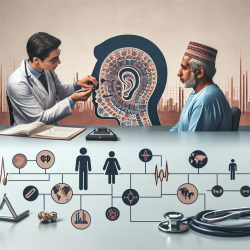Introduction
In the quest to improve physical activity (PA) surveillance among youth, the research article "Traditional surveys versus ecological momentary assessments: Digital citizen science approaches to improve ethical physical activity surveillance among youth" offers compelling insights. The study highlights the limitations of traditional surveys and the potential of ecological momentary assessments (EMAs) to provide more accurate and context-rich data. For practitioners, especially those involved in speech language pathology and online therapy services like TinyEYE, these findings are invaluable in shaping effective interventions and improving outcomes for children.
The Limitations of Traditional Surveys
Traditional surveys, while easy to implement, are plagued by recall bias and overestimation of physical activity levels. The study notes that retrospective surveys can overestimate moderate physical activity by 42 minutes per day and vigorous activity by 39 minutes per day. This discrepancy arises from participants' reliance on memory, which can be faulty and influenced by social desirability.
The Power of Ecological Momentary Assessments
EMAs, on the other hand, offer a real-time, context-aware approach to data collection. By utilizing citizen-owned smartphones, EMAs capture PA as it happens, reducing recall bias and providing a more accurate picture of youth activity levels. The study found a significant difference between PA reported retrospectively and prospectively, with EMAs showing higher accuracy.
Key Findings and Implications
- There is a significant difference between PA reported through traditional surveys and EMAs, with EMAs providing more accurate data.
- Contextual and demographic factors such as ethnicity, parental education, and peer influence play a role in PA levels, which are better captured through EMAs.
- Visible minority youth reported lower PA levels prospectively, highlighting the need for targeted interventions.
For practitioners, these findings underscore the importance of adopting digital tools like EMAs to enhance data accuracy and intervention effectiveness. By leveraging real-time data, practitioners can tailor interventions to the unique needs of each child, improving health outcomes and fostering a more active lifestyle.
Encouraging Further Research
The study opens the door for further exploration into the use of digital citizen science in health surveillance. Practitioners are encouraged to delve deeper into how EMAs can be integrated into their practice, potentially collaborating with researchers to refine these tools and methodologies. Such collaborations can lead to innovative solutions that address the challenges of physical inactivity among youth.
Conclusion
As the digital age continues to evolve, so too must our approaches to health surveillance and intervention. The insights from this study provide a roadmap for practitioners to enhance their practice through data-driven decisions and digital innovation. By embracing EMAs, we can transform how we measure and promote physical activity, ultimately leading to healthier, more active youth.
To read the original research paper, please follow this link: Traditional surveys versus ecological momentary assessments: Digital citizen science approaches to improve ethical physical activity surveillance among youth.










